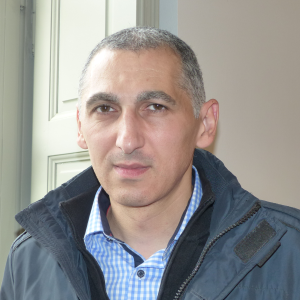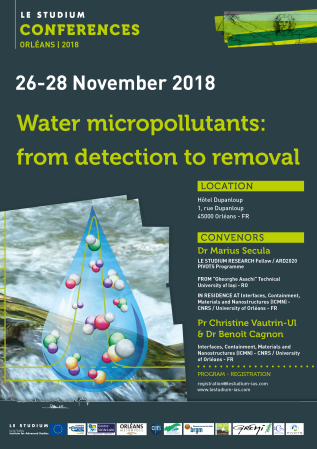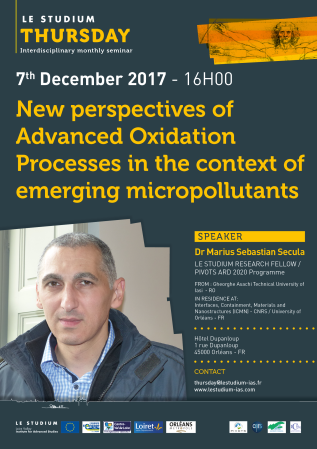Dr Marius Sebastian Secula

Établissement d'origine
Université technique "Gheorghe Asachi" d'Iaşi - RO
Laboratoire d'accueil
Interfaces, Confinement, Matériaux et Nanostructures (ICMN), CNRS /Université d'Orléans - FR
Hôte Scientifique
Dr Benoît Cagnon
PROJET
Developing a new advanced treatment technique for MPs removal from water and wastewater
The presence of emerging micropollutants (MPs) in surface water, groundwater and sediments is currently of major concern, which will lead to the establishment of more stringent standards for the quality of surface water and industrial wastewater, especially in the European Union countries. MPs cannot be completely removed by biological treatment methods. With regard to the possibilities of removing trace organics from waste and drinking water, the performance of various technologies, mostly conventional (adsorption, membrane and oxidation processes), have already been investigated. According to these studies, processes such as ozonation and adsorption on powdered activated carbon (PAC) are seen as promising treatment techniques for wastewater containing MPs. For several years, the laboratory Interfaces, Confinement, Matériaux et Nanostructures (ICMN) in Centre Val de Loire, France, has been active in the development of an advanced oxidative process, in particular O3/Granular Activated Carbon (GAC) combined system, for the elimination of phthalates and pharmaceutical compounds. It is necessary now to develop a new advanced oxidative process by coupling several processes for the mineralization of refractory emergent organic MPs.
Publications
Final reports
Novel cost-efficient Fenton-like catalysts were prepared for the degradation of organic molecules in aqueous solutions. Porous activated carbons (ACs) were directly impregnated with Fe2+ solutions of different concentrations using the wet impregnation method. Their efficiency, as Fenton-like catalysts, was studied. Photo-Fenton tests were performed to establish the performance of the prepared Fe-impregnated ACs in relation to the degradation of organic micropollutants in aqueous solution, under different conditions. Photo-catalytic tests were carried out by means of a laboratory photo-reactor. The influence of several parameters such as solution pH value, initial concentration of the model pollutant, and hydrogen peroxide dose on the process performance was investigated. The ACs and prepared catalysts were characterized by nitrogen adsorption-desorption isotherms at 77K, FTIR, SEM, and thermogravimetric analyses. The total Fe content of the synthesized composites was estimated by the phenanthroline method using UV-Vis spectrophotometry. Photo-catalytic tests were performed in monosolute or mix solutions of MPs in order to compare the efficiency of various conventional AOPs with that of photo-Fenton-peroxone process. The results show an increase in the degradation rate in case of the heterogeneous photo-Fenton-peroxone process.


